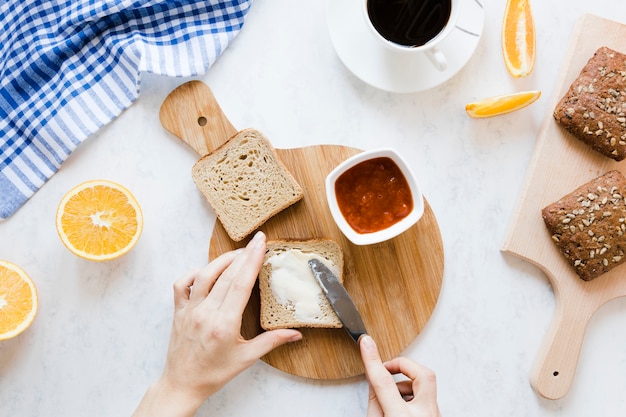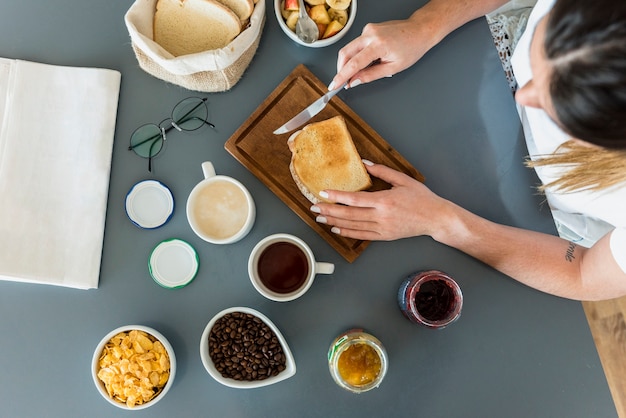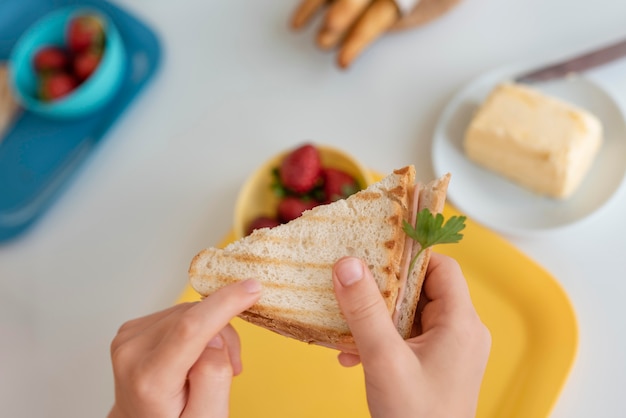Ah, French toast. Just the name conjures up images of lazy weekends, warm kitchens, and the comforting aroma of sweet, caramelized bread. It’s a breakfast classic, a nostalgic dish that brings back childhood memories of happy mornings. But let’s face it, sometimes you want to go beyond the basic recipe and try something a bit more exciting, a bit more…extra. And that’s exactly what we’re going to do today, diving deep into the world of French toast, uncovering hidden gems, and creating some seriously delicious treats.
We'll be covering everything from the essential ingredients and techniques to more creative variations, from classic recipes to global twists. Whether you're a seasoned French toast pro or a newbie in the kitchen, there's something here for everyone. So grab a cuppa, settle in, and let’s get started on this culinary adventure.
(Part 1) The Basics of French Toast: Mastering the Foundations

Like any great dish, French toast is built on a foundation of key ingredients and techniques. Let's break down the essential elements of creating perfect French toast.
Choosing Your Bread: The Canvas for Your Creation
The bread is the foundation, the canvas upon which you'll paint your culinary masterpiece. You want something that will soak up the custard mixture beautifully, offering a rich texture and a hint of chewiness. My go-to bread is challah. Its eggy, slightly sweet flavor makes for a wonderfully decadent French toast. But don't be afraid to experiment! Brioche, with its airy texture and buttery flavor, is another excellent choice. Sourdough, with its tangy notes, adds a surprising dimension. And even a simple loaf of white bread can be transformed into delicious French toast. Just be sure it's not too stale. Freshly baked bread can be a bit too firm and might not soak up the custard as well.
The Perfect Custard: The Heart and Soul of French Toast
Now, let’s talk about the custard. This is where the magic really happens! A good custard is the key to a truly delicious dish. The classic custard is a simple mix of eggs, milk, and a touch of sugar. But why stop there? I love to add a splash of vanilla extract for a touch of warmth and sweetness. It’s like a warm hug in a bowl. Feel free to experiment with other spices like cinnamon, nutmeg, or even a hint of cardamom. And if you're feeling adventurous, you can even add a pinch of salt. It might sound strange, but trust me, it balances out the sweetness and brings out the flavors in a way you wouldn’t believe.
Soaking It Up: Letting the Flavors Mingle
Once you’ve got your bread and custard ready, it’s time to start soaking. The goal is for the bread to absorb the custard mixture, allowing those delicious flavors to meld and infuse the bread. You can simply dip the bread slices in the custard for a few seconds, then transfer them to a hot pan. Or, you can take it a step further and let the bread soak for a few minutes, giving the custard plenty of time to work its magic. Personally, I like to let the bread soak for at least 30 minutes, sometimes even an hour, for an extra-rich flavor. You can even soak the bread overnight! Just make sure to cover it with plastic wrap and store it in the refrigerator.
(Part 2) Cooking Your French Toast: Bringing It to Life

So you've got your bread soaked and ready to go. Now, it's time to take your French toast from preparation to perfection. Here's how to cook it to golden, crispy perfection.
Choosing Your Pan: The Right Tool for the Job
A non-stick pan is your best friend for cooking French toast. It'll ensure a smooth, even cooking process and prevent sticking. Look for a pan that’s big enough to fit your bread slices without overcrowding them. cast iron pans are also great, adding a touch of rustic charm and imparting a subtle smoky flavor. Just make sure you preheat your pan over medium heat before you start cooking.
Getting the Right Colour: Achieving a Golden Glow
We all know the feeling—that moment when you see the French toast start to turn a beautiful golden brown. It's a sign that it's reaching peak deliciousness! To achieve this, cook it slowly over medium heat. Don't rush the process. Let the bread cook gently, allowing the custard to set and the outside to achieve a crispy texture. You can flip the slices once they start to set on the bottom and become golden brown. If you rush it, you’ll end up with French toast that’s undercooked on the inside.
Avoid Overcrowding: Giving Each Slice its Own Space
Here's a common mistake that can lead to soggy French toast: overcrowding the pan. Just like when you’re baking cookies, you want to give each slice enough space to cook properly. If you overcrowd the pan, the steam from the cooking French toast won’t have a chance to escape, resulting in a soggy, undercooked mess. If you’re making a large batch, consider cooking it in batches to ensure even cooking.
(Part 3) Variations on the Classic: Expanding Your French Toast Horizons

We've covered the fundamentals, but now it's time to have some fun! Let's explore the world of French toast variations, turning this breakfast staple into a culinary adventure.
Sweet and Savoury: A World of Flavour
French toast is a blank canvas for creativity. You can keep things classic with a simple sugar dusting or a drizzle of maple syrup. Or, you can go bold with toppings like whipped cream, fresh berries, a sprinkle of chopped nuts, or a scoop of vanilla ice cream. For a more adventurous twist, try adding a dollop of ricotta cheese, a drizzle of honey, or a sprinkle of crumbled bacon. Remember, the key is to experiment and have fun!
Going Global: Bringing the World to Your Plate
French toast isn’t just a Western dish. Around the world, different cultures have their own unique takes on this breakfast classic. In Japan, you’ll find French toast served with a sweet and tangy glaze, often paired with fruit and whipped cream. In Mexico, they often add a bit of cinnamon and sugar, creating a warm, comforting flavor. Explore different cultures and cuisines to discover unexpected flavor combinations.
From Sweet to Savoury: Thinking Outside the Box
Why not try making a savoury French toast? Swap the sweet custard for a savoury one made with herbs, spices, and even cheese. You could even use a bit of Dijon mustard or a touch of horseradish for a real kick. Serve it with a side of bacon, sausage, or sauteed mushrooms for a truly unique and satisfying breakfast experience.
(Part 4) French Toast for Everyone: Catering to Different Tastes and Needs
French toast is a dish that can be enjoyed by everyone, from kids to adults, and can be adapted to suit a variety of dietary needs and preferences.
French Toast for the Whole Family: A Breakfast Delight for Everyone
Kids love French toast! It’s easy to make and customize. Use their favourite fruits, sprinkles, or even chocolate chips. For a healthier option, use whole-wheat bread or add some fruit to your custard.
French Toast for the Health-Conscious: Balancing Flavor and Nutrition
You can make French toast a bit healthier by using low-fat milk or even almond milk in your custard. You can also swap the sugar for a natural sweetener like honey or maple syrup. And don’t be afraid to add some protein to your French toast. A sprinkle of nuts, a dollop of yoghurt, or a few slices of fruit can give you that extra boost.
French Toast for the Gluten-Free: Making Delicious Gluten-Free Choices
If you’re gluten-free, you can still enjoy French toast! There are plenty of delicious gluten-free breads available in supermarkets. Just be sure to check the packaging to make sure it’s gluten-free. You can also make your own gluten-free bread at home.
(Part 5) French Toast Beyond the Plate: Expanding Your Culinary Horizons
French toast is so much more than just a breakfast dish. It can be transformed into a delicious dessert or even a decadent brunch treat. Let's explore these exciting possibilities.
French Toast Dessert: A Sweet Treat for the End of the Meal
Imagine a warm, gooey French toast topped with a scoop of vanilla ice cream, a drizzle of chocolate sauce, and a sprinkle of chopped nuts. Sounds dreamy, right? French toast makes a delicious and satisfying dessert. You can even use a sweet custard for a more dessert-like experience.
French Toast Brunch: A Perfect Dish for Weekend Gatherings
French toast is the perfect dish for brunch. It’s easy to make, adaptable, and can be served with a variety of sides. Try serving it with fruit, bacon, sausage, or even a savoury side like roasted vegetables.
(Part 6) Mastering the Art of French Toast: Tips and Tricks for Success
Even the simplest recipes can throw us a curveball sometimes. But don’t worry, here are a few tips and tricks to help you master the art of making perfect French toast.
Tips and Tricks: Secrets to Perfect French Toast
To avoid soggy French toast, make sure your bread is not too stale. You want it to soak up the custard but not become too mushy. Don’t overcrowd your pan. Give each slice enough space to cook properly. Flip your French toast only once, when it’s golden brown on the bottom. And don’t be afraid to experiment with different flavors and ingredients. The possibilities are endless.
(Part 7) The French Toast Cookbook: Recipes to Inspire Your culinary journey
Alright, I know what you’re thinking: “I’m ready for some recipes!” So let’s get to it. Here are a few of my favourite French toast recipes that I’ve been perfecting over the years. These recipes are the result of countless kitchen experiments, and I'm confident you'll enjoy them as much as I do.
Classic French Toast: A Timeless Recipe
This is the recipe I go back to time and time again. It’s simple, easy, and always delivers.
- Ingredients:
- 4 slices of bread (challah, brioche, or sourdough)
- 2 large eggs
- 1/2 cup milk
- 1 tablespoon sugar
- 1 teaspoon vanilla extract
- Butter or cooking spray
- Maple syrup, for serving
- Instructions:
- In a shallow dish, whisk together eggs, milk, sugar, and vanilla extract until well combined.
- Dip each slice of bread into the custard mixture, making sure to coat both sides. Let the bread soak for a few minutes.
- Heat butter or cooking spray in a non-stick pan over medium heat.
- Add the bread slices to the pan and cook for 2-3 minutes per side, or until golden brown.
- Serve immediately with maple syrup.
Cinnamon French Toast: A Warm and Spicy Delight
This recipe is perfect for those who love a bit of spice in their French toast.
- Ingredients:
- 4 slices of bread (challah, brioche, or sourdough)
- 2 large eggs
- 1/2 cup milk
- 1 tablespoon sugar
- 1 teaspoon vanilla extract
- 1 teaspoon cinnamon
- Butter or cooking spray
- Maple syrup, for serving
- Instructions:
- In a shallow dish, whisk together eggs, milk, sugar, vanilla extract, and cinnamon until well combined.
- Dip each slice of bread into the custard mixture, making sure to coat both sides. Let the bread soak for a few minutes.
- Heat butter or cooking spray in a non-stick pan over medium heat.
- Add the bread slices to the pan and cook for 2-3 minutes per side, or until golden brown.
- Serve immediately with maple syrup.
Chocolate Chip French Toast: An Indulgent Treat
This recipe is a real crowd-pleaser. It’s rich, indulgent, and perfect for a special occasion.
- Ingredients:
- 4 slices of bread (challah, brioche, or sourdough)
- 2 large eggs
- 1/2 cup milk
- 1 tablespoon sugar
- 1 teaspoon vanilla extract
- 1/2 cup chocolate chips
- Butter or cooking spray
- Maple syrup, for serving
- Instructions:
- In a shallow dish, whisk together eggs, milk, sugar, and vanilla extract until well combined.
- Stir in the chocolate chips.
- Dip each slice of bread into the custard mixture, making sure to coat both sides. Let the bread soak for a few minutes.
- Heat butter or cooking spray in a non-stick pan over medium heat.
- Add the bread slices to the pan and cook for 2-3 minutes per side, or until golden brown.
- Serve immediately with maple syrup.
(Part 8) FAQs: Answering Your French Toast Questions
Let’s be honest, there are always questions about French toast. So let’s tackle some of the most common ones.
1. What kind of bread is best for French toast?
As I said earlier, challah bread is a great choice because of its rich, eggy texture. But you can also use brioche, sourdough, or even a good old loaf of white bread. Just avoid using bread that’s too stale or too fresh. You want something that will soak up the custard mixture nicely without becoming too soggy.
2. How long should I soak the bread in the custard?
You want the bread to soak up the custard mixture but not become mushy. Soak the bread for a few minutes. You can even do this overnight for an extra rich and decadent French toast. Just be sure to cover your bread with plastic wrap and keep it in the fridge.
3. What’s the best way to cook French toast?
A non-stick pan is your best bet. Just make sure you preheat your pan over medium heat before you start cooking. Cook the French toast slowly over medium heat. You’re aiming for a beautiful golden brown colour on both sides. Avoid overcrowding the pan. Give each slice enough space to cook properly.
4. What are some creative ways to serve French toast?
The possibilities are endless! You can keep things classic with a simple sugar dusting or go for a more adventurous flavour profile. Try adding a drizzle of maple syrup, a dollop of whipped cream, or a sprinkle of fruit. For a savoury twist, you could add a touch of cheese, a dollop of sour cream, or some sauteed mushrooms.
5. Can I make French toast ahead of time?
Yes, you can! Just soak the bread in the custard overnight. Store the bread in the refrigerator, covered with plastic wrap. When you’re ready to cook, simply heat butter or cooking spray in a non-stick pan over medium heat, add the bread slices to the pan, and cook for 2-3 minutes per side, or until golden brown.
(Part 9) Conclusion: Embracing the French Toast Journey
And there you have it, the ultimate guide to delicious French toast. I hope you’ve learned a thing or two, and I’m sure you’re ready to go out there and whip up some seriously delicious treats. Remember, the key to making perfect French toast is to have fun and be creative. Experiment with different flavours and ingredients, and don’t be afraid to go beyond the basics. You might just surprise yourself with what you create.
Everyone is watching

How to Cook Frozen Lobster Tails Perfectly: A Step-by-Step Guide
RecipesLobster. Just the word conjures up images of lavish meals, special occasions, and a taste of luxury. But let's...

Pigs in a Blanket Cooking Time: How Long to Bake for Perfect Results
RecipesAh, pigs in a blanket. Just the name conjures up images of those delightful little parcels of crispy pastry en...

Pork Fillet Cooking Time: How Long to Cook It Perfectly
RecipesPork fillet, or tenderloin as it's sometimes called, is a real favourite in our house. It's so versatile, and...

The Ultimate Guide to Cooking Delicious Frankfurters
RecipesLet's face it, we all love a good frankfurter. It's a classic, simple, and always satisfying. But let's be rea...

Wolf Meat Recipes: A Guide to Cooking Wild Game
RecipesLet's be honest, you don't see wolf meat at your local butcher shop every day. It's a bit of a wild card, but ...
